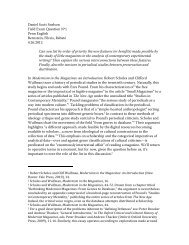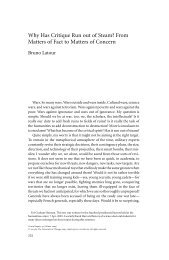The Exploit: A Theory of Networks - asounder
The Exploit: A Theory of Networks - asounder
The Exploit: A Theory of Networks - asounder
You also want an ePaper? Increase the reach of your titles
YUMPU automatically turns print PDFs into web optimized ePapers that Google loves.
44 Nodes<br />
<strong>The</strong> third layer is the Internet layer. This layer is more fundamental still<br />
than both the application and transport layers. <strong>The</strong> Internet layer is concerned<br />
with one thing: the actual movement <strong>of</strong> data from one place to<br />
another.<br />
<strong>The</strong> Internet layer contains the source address <strong>of</strong> the machine sending<br />
the data, plus the destination address <strong>of</strong> the machine receiving<br />
the data. It is not aware <strong>of</strong> the type <strong>of</strong> data it is sending, simply the<br />
sender and receiver machines for that data. <strong>The</strong> Internet layer guides<br />
messages as they are routed through complex networks. It is also able<br />
to repackage the message in such a way as to fit through very small<br />
pipes or flow quickly through large ones.<br />
<strong>The</strong> fourth layer, the physical layer, is the protocol layer specific to the<br />
actual material substrate <strong>of</strong> the communication network.<br />
Copper wires have different physical properties from fiber - optic<br />
wires, despite the fact that both are able to transport an e - mail from<br />
one place to another. <strong>The</strong> physical - layer protocols interface directly<br />
with photons, electrons, and the material substrate, be it glass or metal<br />
or another medium, that allows them to flow. Consequently the physical<br />
layer is highly variable and differs greatly depending on the technology<br />
in question. It is less <strong>of</strong> a purely s<strong>of</strong>tware - based layer in that it<br />
must take into account the material properties <strong>of</strong> the communications<br />
medium.<br />
We wish to foreground the layer model <strong>of</strong> the Internet for several reasons.<br />
<strong>The</strong> first is to illustrate the technical basis for how multiple or “exceptional”<br />
topologies may coexist in the same network.<br />
A classic example is the topological schism between the Domain<br />
Name System and the Internet protocol, two technologies that are in -<br />
tensely interconnected but are structured on radically different models<br />
<strong>of</strong> network control and organization: the Domain Name System is a<br />
database <strong>of</strong> information that is centralized in its core administration<br />
but decentralized in its global implementation (there are a limited









